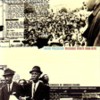Henri Pousseur, "Musique Mixte 1966-1970"
 The fourth Henri Pousseur CD in Sub Rosa’s Early Electronics series features two long works. Although his condensation of his own interpretation of the Faust legend has been heard infrequently, this is the premiere of "Crosses of Crossed Colors" and to me is the more intriguing and powerful of the two.
The fourth Henri Pousseur CD in Sub Rosa’s Early Electronics series features two long works. Although his condensation of his own interpretation of the Faust legend has been heard infrequently, this is the premiere of "Crosses of Crossed Colors" and to me is the more intriguing and powerful of the two.
The three movements of "Crosses of Crossed Colors" employ two pianos as well as turntable and tape machine operators who all support highly-accoladed solo vocalist Joy Blackett. Pousseur, who believes in open works that allow for improvisation, uses Blackett in the call and response gospel style that was central to the development of jazz and blues. Blackett uses her powerful, incantatory voice primarily to recite variations of a speech given by 19th Century Native American leader Chief Seattle, which emphasizes the sanctity not only of all men, but also the very land on which they live. After each of Blackett’s statements, the other musicians answer with piano phrases; radio snippets of news programs, conversations, and popular music; and record excerpts of operatic notes and indigenous music. Blackett links Chief Seattle’s sentiments to the Civil Rights Movement of the 20th Century to stirring effect. Not only is Blackett’s performance moving, it’s also particularly relevant even today to the problems of racism faced in the aftermath of Katrina and to the ecological emergency the planet faces as its resources are obliterated at an astonishing rate. If anything, the persistence of these issues highlights how important they remain.
In contrast, any issues are handled obliquely in "Jeu de Miroirs de Votre Faust," which is basically a tape collage "diary" of a previous performance of Pousseur’s original composition, mixing its themes, lyrics, and even syllables into a non-linear, fragmented version of the original. The result is mostly enjoyable, though I must admit that I would have gotten more out of it were my French better. Still, its construction alone is fascinating enough to make the recording compelling.
Although both pieces have structural similarities, Blackett’s performance alone makes "Crosses of Crossed Colors" the highlight, and the opus might one day be considered one of Pousseur’s best works.
samples:
- Crosses of Crossed Colors, Part One
- Crosses of Crossed Colors, Part Three
- Jeu de Miroirs of Votre Faust
 



